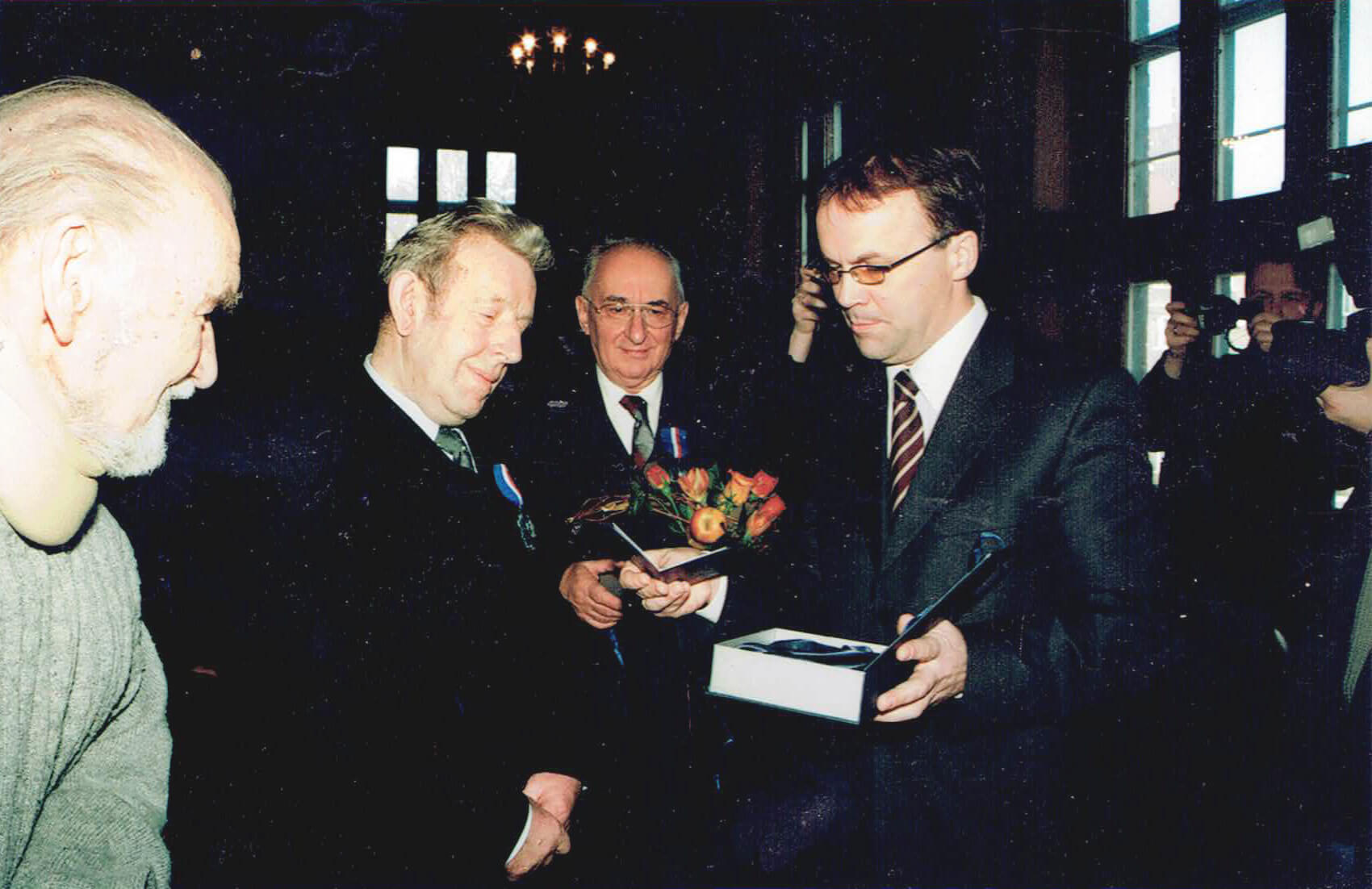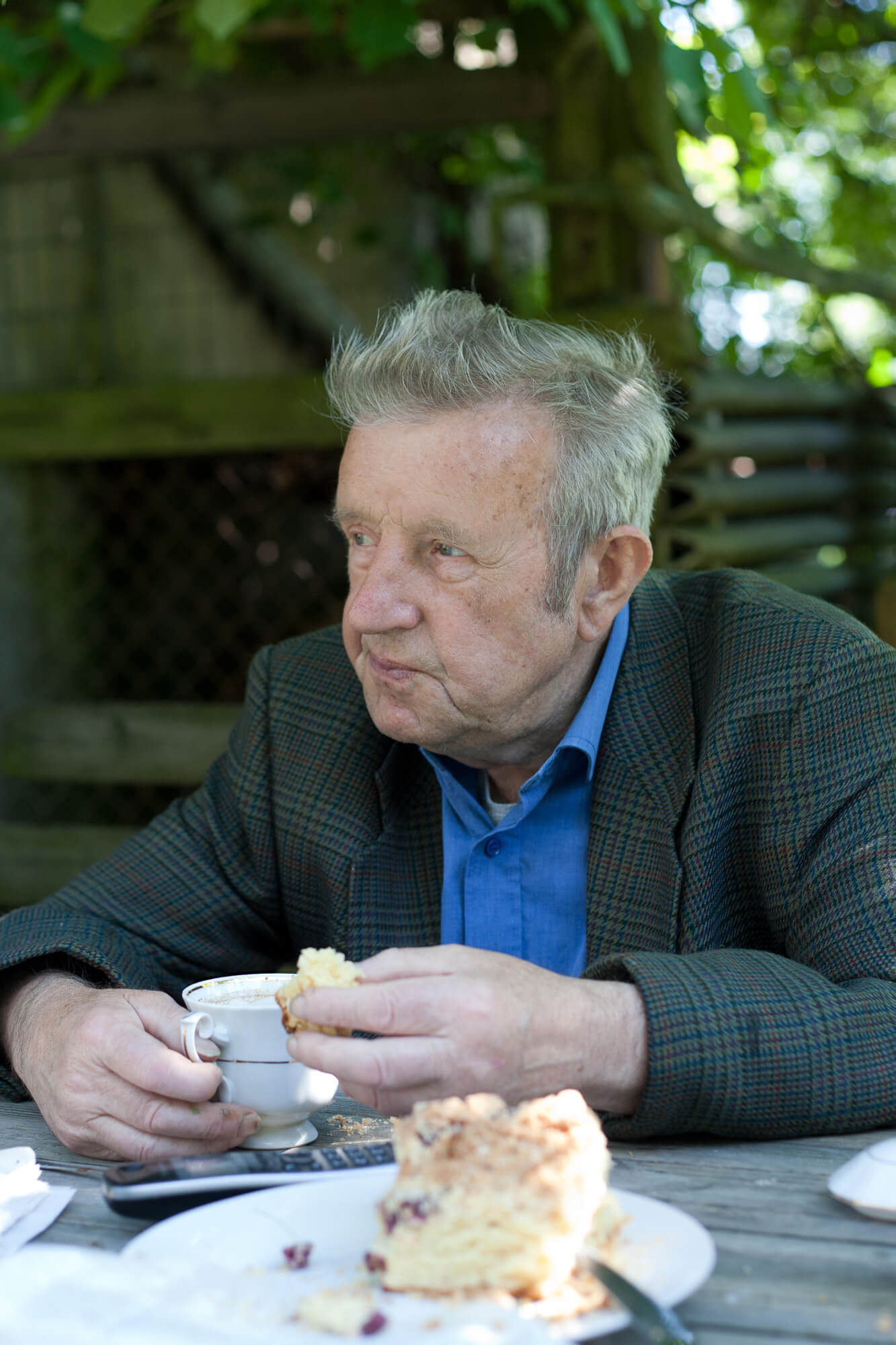Józef Chełmowski
fot. L. Pękalski

On February 26, 1934, another child of Marianna and Konrad Chełmowski was born. He was given the name of Józef. He was born and grew up in the house where he lived his whole life. He grew up among two brothers and two sisters. He was 5 years old when World War II broke out. He started his education at a German school, where he unintentionally learned the language and trained calligraphy. After the war ended, he continued elementary school in Polish, which he did not manage to learn perfectly. He completed his education at the elementary level. Years later, he repeatedly mentioned his teacher from technical and English classes. Józef appreciated him for his wisdom and for the fact that he gave freedom in class, allowing him to develop his interests and painting talent. The distance to himself made him not worry about education deficiencies, and his curiosity about the world motivated him to explore his knowledge on his own.
He did not attend art schools. Even if he had such a need, life arranged a different scenario for him. He spent his time on compulsory military service as a radiomechanic in aviation, which he later mentioned many times in his works and projects. After completing his military service, Józef started a family. He and his wife Jadwiga had two daughters: Ewa and Jolanta.
Post-war poverty and the dynamic family situation influenced the need for paid work. However, this was not only an obligation, but a new experience and inspiration. Józef worked in a road company as a laboratory technician. Perhaps it was thanks to this professional experience that he was not afraid to experiment with materials or paints.
For several years, he was a ticket seller in the Sława cinema in Brusy, where he had the opportunity to watch newsreels, which at that time was one of the most interesting forms of obtaining knowledge. He used the obtained information for the purposes of broadly understood creative activity. In his rich biography, it is worth mentioning his work at the “Las” Brusy company. The undemanding position of the watchman, especially at night, was favorable to carving small chapels. His handicraft was appreciated by his employer who organized Józef’s first exhibition in the company’s canteen.
In addition, local residents may also remember him as a switchman at the Brusy railway station. He happened to commute to work on a peculiar double-decker bicycle of his own design. The job on the railroad was Józef’s last paid job, and in the following years he devoted himself only to developing his passion and working on the farm.
After crossing the figurative border of his 40th birthday, being an artist absorbed him completely. He developed his style by trial and error. He did not create for money or for lack of work, which, as he claimed, he had more than enough in the field. On the other hand, he was driven to take up new artistic challenges by an inner need. In his works, he paid particular attention to the Creator, nature, cosmos, tradition and the Kashubian region close to his heart. Initially, he treated sculpture as the leading form of art, but what couldn’t be expressed in sculpture, Józef painted. He also constructed unusual objects, including: instruments, a double-decker bicycle, opening up and playing sculptures and paintings, an element catcher and many more.
Chełmowski’s work is almost always a work with an attachment. It can be a comment in the form of a quote, golden thought, folk wisdom, adopted or own thoughts. Out of inner need and respect for the past, he collected items once used in the household, ritual exhibits, old denominations and war artifacts. He was also creating a beekeeping open-air museum, which was gradually enriched by large-size carved beehives of his own making. Year after year, it attracted more and more intrigued tourists and journalists.
He and his wife, Jadwiga, worked on the 5-hectare farm in the traditional way. Working in the field allowed him to distance himself from philosophical considerations. As he himself used to say, thanks to physical work, he was able to detach himself and collect the thoughts needed to create next works.
Józef’s creativity gained momentum. There were numerous exhibitions and individual awards. His works could be admired not only in Poland, but also abroad – in Germany, France, Russia, Belarus, Ukraine and Slovenia. Chełmowski also received grants for creating art projects. He was appreciated in the artistic environment, as proved by recognition awards, including the most significant ones: the Stolem Medal (1995), the Grand Prix in the Teofila Ociepka (1996), entry in the honorary book of Meritorious Citizens of the City and Commune of Brusy (1998), Pomeranian Art Award (2004). He received the Grand Prix for the greatest work he created
over several years – the painting “Panorama of the Apocalypse of St. John “, which can currently be admired in the West-Kashubian Museum in Bytów.

The mature Józef is an established artist. At that time, he treated sculpture and painting on an
equal footing, and the seasons set a simple system of work – sculpture in the summer and painting and philosophizing in the winter.
Experts in the field call people like him “an inhabitant of his own space”. By no means was he
shutting himself up in it! On the contrary, he invited people to his world and shared it willingly. The house and the yard at Brusy-Jaglie 17 have become a tourist attraction of the region, described in many tourist guides. Why did guests come here? For a meeting with art and philosophy or hoping that they will be able to buy or order a work from Chełmowski’s workshop? Certainly, the conversation with the creator was a complement to the visit.
Chełmowski’s works could still be seen at numerous exhibitions. Over the years, a group of enthusiasts of his work grew. Receiving the Silver Gloria Artis Medal in 2006 was an
extremely important recognition for the artist’s creative work.
Chełmowski remained himself. He stayed true to himself and continued his simple life in the family household, he contemplated on ultimate topics a little more, and remained open to people, and others began to write his story. Inspired by an artist who is not obvious and at the same time extremely sincere, it has resulted in many independent works based on the living legend of Kashubian culture. Folk Art Competition is a cyclical and interesting initiative for
folk artists not only sustaining the memory of the Artist, but also enabling development and wider recognition. The first edition of the competition was organized in 2019.
Józef Chełmowski passed away unexpectedly on July 6, 2013, on the Day of the World Congress of Kashubians. He spent the last day at his home, in full-bloomed garden, among those closest to him. Perhaps that is why one can get the impression that he is about to step out of his studio to smile at his guest and tell them about what is currently on his mind.

Over the years, Chełmowski’s works have been collected by lovers of his art, but also by museum institutions.

Apart from the artist’s house, the largest museum collection is the West Kashubian Museum in Bytów (as many as 561). From February 2021, you can see part of the collection at the permanent exhibition devoted to Chełmowski

The Museum in Chojnice undertook a research query of the Artist’s works in private collections. The results of the search resulted in 451 works that were photographed and listed
Over a hundred of the artist’s works are also in the possession of the Maria Znamierowska-Prüffer Ethnographic Museum in Toruń
Józef Chełmowski and his work have received attention in the following publications, albums and films.
Józef Chełmowski is the protagonist of several films. You can watch him work and listen to his stories by clicking on the links below.
There are also many conversations with the Artist available. Archival recordings by journalists of the Polish Radio PiK, especially Mr. Andrzej Krystek, can be listened to on the website of Polish Radio PiK by entering the search term: chełmowski
The listed items are only a fraction of works devoted to Józef Chełmowski – being at the same time the most accessible. The artist’s private archive consists of smaller publications and hundreds of photographs, dozens of press articles and several films.
We invite you to cooperate in order to expand the catalog of additional materials.